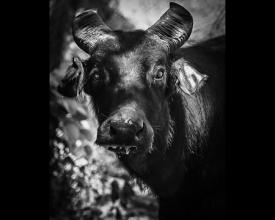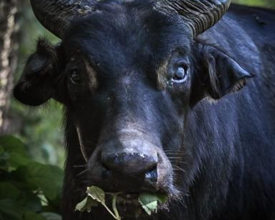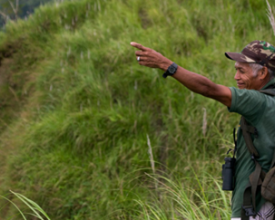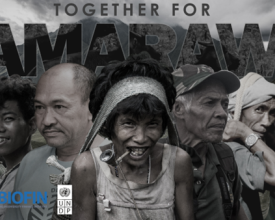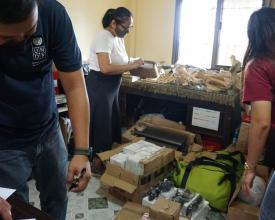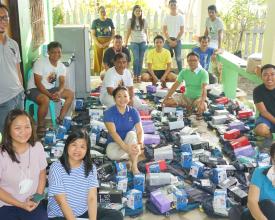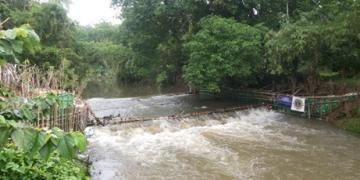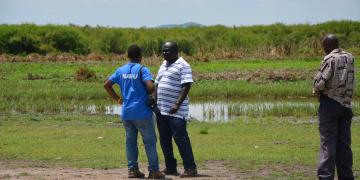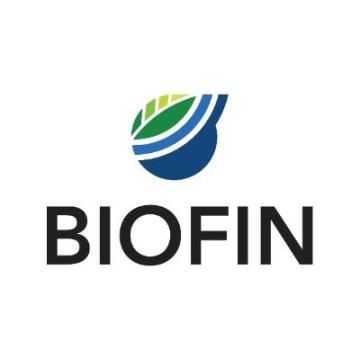
Together for Tamaraws Crowdfunding Campaign: Protecting Endangered Species and Supporting Local Livelihoods in Times of Crisis
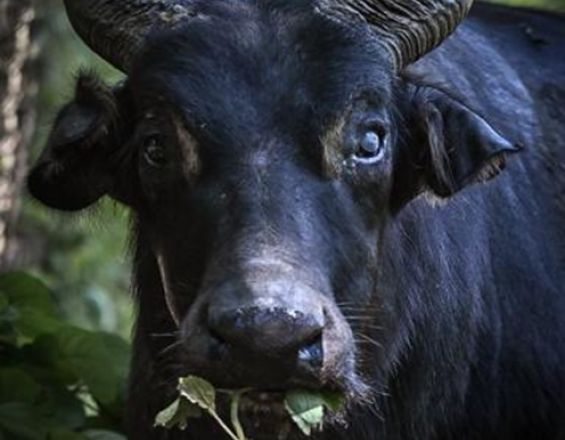
The tamaraw is a small buffalo species exclusive to the island of Mindoro in the Philippines. Classified as critically endangered by the International Union for Conservation of Nature (IUCN), it is primarily threatened by poaching. Most of the remaining population lives in the Mounts Iglit-Baco Natural Park.
The protection of the tamaraws relies on the patrolling of rangers and wardens. During COVID-19 pandemic, the park lost the revenue it collected from tourists and used to pay the salaries of patrol frontliners. As a result, 33 of them were furloughed. Moreover, poachers increased their presence in the area amid a reduced number of visitors.
To address this scenario, UNDP-BIOFIN and its partners launched the "Together for Tamaraws" crowdfunding campaign. Active from July to December 2020, it raised funds to cover six months of salaries for the furloughed frontliners, provided food packs, purchased patrol gear and equipment. The campaign raised USD 32,026.03, surpassing its initial goal of USD 22,980 by nearly 40%.
Contexte
Challenges addressed
About 600 tamaraws remain, found only in Mindoro. 480 of them live within the Mounts Iglit-Baco Natural Park, which covers 106,555 hectares. Current threats to the tamaraws include illegal poaching, habitat degradation, and changing land use.
59 frontliners (24 rangers and 35 wardens) regularly patrol the protected area. They are hired on a contractual basis under the national Tamaraw Conservation Program (TCP) of the Department of Environment and Natural Resources (DENR) and the parks' Protected Area Management Office (PAMO). Wardens also work as porters and guides for visitors. Most frontliners come from the Mangyan indigenous people, which include three subgroups in Mindoro: the Tau-Buid, Buid, and Bangon tribes.
With COVID-19, all tourism activities in Mindoro were suspended. 33 frontliners (32 wardens and one ranger) were furloughed and lost their income. The reduced presence of visitors and patrollers encouraged poachers to increase their activity, putting the tamaraws at greater risk.
Emplacement
Traiter
Summary of the process
The use of traditional and social media as marketing instruments is closely linked to the solution's two other building blocks.
First, the crowdfunding campaign was designed with a strong social media presence, which made it possible to reach diverse audiences and younger generations. This strategy facilitated the inclusion of the Tamaraw Society initiative, as it relied on the same approach. The two reinforced each other: awareness raised through the campaign's own posts increased public visibility and willingness to contribute to the Tamaraw Society's fundraising activities, while the latter also enhanced overall awareness about the campaign.
Second, the combination of the campaign's own media outreach and the Tamaraw Society's fundraising activities enabled the campaign to exceed its initial target, securing sufficient resources to purchase patrol gear and equipment. This, in turn, supported long-term efforts to protect the tamaraws.
Building Blocks
Use of traditional and social media as marketing instruments to accelerate awareness rais-ing and resource mobilization
The crowdfunding campaign maintained a strong presence on traditional and social media. Daily posts were tailored to strengthen the business case for donations, highlighting key events such as the Tamaraw Month, the death of the last captive-bred tamaraw, Kalibasib, and a tamaraw killed by poachers. By leveraging a mix of media platforms, the campaign reached both national and international audiences and engaged diverse age groups.
Social media posts were reposted and shared by BIOFIN Global and Philippines, UNDP Philippines, and various accounts of the Department of Environment and Natural Resources (DENR). Moreover, a national Tamaraw Ambassadors program was launched on social media, engaging public figures to promote the campaign. These communication strategies effectively reached the general public within and beyond the Philippines.
Traditional media also supported the campaign, with coverage from reputable news networks like Stand for Truth and GMA Digital Specials.
Lastly, a promotion email was sent to over 2,000 individuals through the BIOFIN global mailing list, targeting a specialized audience of professionals and partners in the biodiversity sector.
Enabling factors
A key enabling factor was the established presence and reputation of UNDP in the Philippines, along with its partnership with relevant actors such as the DENR. This contributed to the rapid promotion of the campaign across social media, quick engagement of public figures, and the public's trust in the initiative. The donation of USD 4,400 from Congresswomen Josephine Ramirez Sato to kick start the campaign, being the highest contribution, was important for the momentum of the campaign.
Lesson learned
A key lesson learned is that an effective marketing campaign should leverage multiple media platforms and tailor its messages to engage diverse audiences. While the Tamaraw Ambassadors program likely helped reach younger audiences and social media users, the campaign advertisements in printed media may have been more effective with older audiences.
The main challenge in the marketing strategy was the inability to produce new on-site photos and videos, given travel restrictions and budget constraints for hiring specialized personnel. This was addressed by creatively using existing materials, such as video clips from the 2019 documentary film Suwag o Suko and photos from the 2018 Biodiversity Camp—an initiative from UNDP-BIOFIN and the TCP that gathered journalists and influencers in the natural habitat of tamaraws to raise awareness about the need to mobilize funds for their protection.
Catalyzing Additional Resources via Social Engagement and Champions: the Tamaraw Society
To support the crowdfunding campaign, the Philippine Parks and Biodiversity launched the Tamaraw Society initiative in July 2020.
The Philippine Parks and Biodiversity is a non-profit, non-governmental organization (NGO) dedicated to conserving the country's biodiversity through multistakeholder partnerships, ranging from grassroot communities to the private sector.
The Tamaraw Society consisted of a group of organizations and individuals, mostly from younger generations, who committed to running their own fundraising activities to support the crowdfunding campaign with at least USD 400 each (PHP 20,000 at the time). The 19 participants, referred to as champions, collectively raised USD 7,789 (PHP 389,450). They conducted activities such as online raffles of film cameras, online selling of secondhand clothes, auction of digital artworks, and merchandise sales such as tamaraw tote bags and shirts.
Enabling factors
A key enabling factor was the pre-existing expertise of the Philippine Parks and Biodiversity in running champion-based initiatives. The NGO had previously called for private sector and individual champions to support its programs as a creative financing method, which helped the implementation and success of the Tamaraw Society initiative.
Lesson learned
A key lesson learned is that creative financing solutions can complement broader strategies, such as crowdfunding, by actively engaging civil society around a shared cause.
Using funds for long-term improvement in patrolling conditions
The main objective of the crowdfunding campaign was to cover six months of salaries for the 33 furloughed frontliners. In addition, funds were allocated to provide food packs for all 59 frontliners during their 22-day shifts and essential patrolling gear and equipment were procured, generating a long-term benefit beyond the campaign period.
Enabling factors
Enabling factors include the availability of funds beyond the initial target, which made it possible to first cover the salaries of frontliners and then procure the gear and equipment. The fact that funds were not fully earmarked also contributed to this outcome.
Lesson learned
While crowdfunding may be best suited for specific events or short-term campaigns—having limited effectiveness as along-term fundraising strategy—it can be designed to allocate a share of funds, even if small, to outputs that will endure in the future. This boosts the overall impact of the campaign and strengthens its contribution to biodiversity protection.
Impacts
The crowdfunding campaign raised USD 32,026.03 (equivalent to PHP 1.6 million at the time), exceeding its initial goal of USD 22,980 (PHP 1.1 million) by almost 40%. The Tamaraw Society contributed 24 percent (USD 7,789) of the total while 81 percent of the contributions came from within the country.
Funds were used to pay the salaries of the 33 furloughed frontliners for six months and to provide patrol assistance in the form of food packs for the regular 59 wardens and rangers. The remaining funds were used to purchase much-needed patrol gear and equipment to improve the protection of the Tamaraws, as detailed in building block three.
As an indirect outcome, the success of the campaign helped unlock an additional USD 25,000 from the global BIOFIN team to BIOFIN Philippines for the implementation of the Tamaraw Conservation Plan.
Beneficiaries
Direct beneficiaries include the 59 frontliners who received any form of assistance and the Tamaraw population. Indirect beneficiaries comprise the frontliners' households, Indigenous groups, tourists, and the general population.
Global Biodiversity Framework (GBF)
Sustainable Development Goals
Story
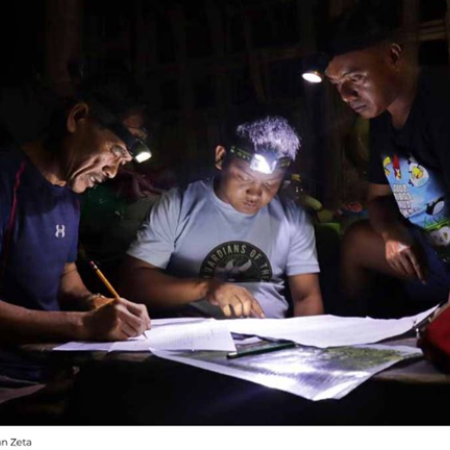
Eduardo Bata has served as a team leader and ranger for the Tamaraw Conservation Program (TCP) for the past 36 years. In an interview for UNDP-BIOFIN’s Investing in the Planet’s Safety Net: Stories from the Field publication he shared his connection to the tamaraws and described how the COVID-19 pandemic affected his family.
Eduardo explained that residents of Mindoro take great pride in the tamaraws, as the species can only be found on this island. The TCP estimates that in the early 1900s, the tamaraw population was around 10,000. However, due to poaching, habitat degradation, and changing land use, they have become confined to the highlands. Eduardo shared his concerns about this situation with a call to action:
"We must protect the tamaraws from poaching and hunting. They should be left in peace to reproduce and grow their population. We do not want the children of our children to no longer be able to see wild tamaraws because we failed to protect the animals".
Rangers' shifts last 22 consecutive days. Eduardo highlighted that these can be challenging periods — being away from family and children, walking long distances, and facing the risk of encountering armed poachers. But the work is rewarding for him.
With the pandemic and resulting interruption in tourism, Eduardo and his family lost almost all income. That is where the Together for Tamaraws crowdfunding campaign made a difference. Eduardo noted that the allowance provided a "huge help" for his family and described it as "heart-warming to know that Filipinos and global citizens alike, of various age groups, incomes, and interests have supported" the frontliners. He also highlighted that the purchase of gear and equipment was essential to improve both current and future patrolling. He concluded by saying that being apple to support the tamaraws and see their population grow, even if slowly, brings him great "joy and honor".
We invite you to read Eduardo's full story through the following link.

